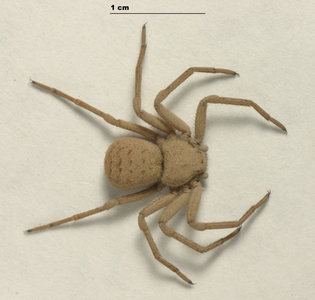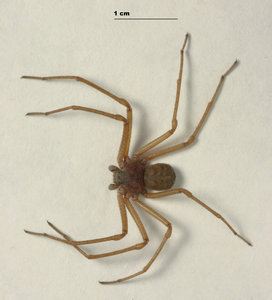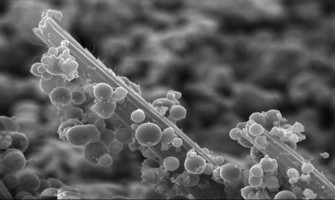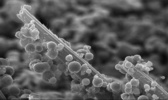Sicarius



This tree diagram shows the relationships between several groups of organisms.
The root of the current tree connects the organisms featured in this tree to their containing group and the rest of the Tree of Life. The basal branching point in the tree represents the ancestor of the other groups in the tree. This ancestor diversified over time into several descendent subgroups, which are represented as internal nodes and terminal taxa to the right.

You can click on the root to travel down the Tree of Life all the way to the root of all Life, and you can click on the names of descendent subgroups to travel up the Tree of Life all the way to individual species.
For more information on ToL tree formatting, please see Interpreting the Tree or Classification. To learn more about phylogenetic trees, please visit our Phylogenetic Biology pages.
close boxReferences
Binford, G.J., Callahan, M.S., Bodner, M.R., Rynerson, M.R., Berea N??ez, P., Ellison, C.E., Duncan, R.P. 2008. Phylogenetic relationships of Loxosceles and Sicarius spiders are consistent with Western Gondwanan vicariance. Molecular Phylogenetics and Evolution 49:538-553.
Duncan, R.P., Autumn, K., Binford, G.J., 2007. Convergent setal morphology in sandcovering spiders suggests a design principle for particle capture. Proceedings of the Royal Society B: Biological Sciences 274 (1629), 3049?3056.
Information on the Internet
- Six-eyed sand spider lunges for lunch. Oregon Public Broadcasting video footage of Sicarius burying themselves in sand and catching prey.
Title Illustrations

| Scientific Name | Sicarius terrosus |
|---|---|
| Location | Parque Sierra de las Quijadas, Argentina |
| Creator | Dr. Kenneth Cramer |
| Specimen Condition | Live Specimen |
| Image Use |
 This media file is licensed under the Creative Commons Attribution-NonCommercial License - Version 3.0. This media file is licensed under the Creative Commons Attribution-NonCommercial License - Version 3.0.
|
| Copyright |
© 2005 Greta Binford

|
| Scientific Name | Sicarius albospinosus |
|---|---|
| Creator | Dr. Kenneth Cramer |
| Specimen Condition | Live Specimen |
| Image Use |
 This media file is licensed under the Creative Commons Attribution-NonCommercial License - Version 3.0. This media file is licensed under the Creative Commons Attribution-NonCommercial License - Version 3.0.
|
| Copyright |
© 2005 Greta Binford

|
| Scientific Name | Sicarius |
|---|---|
| Comments | A Sicarius in the field in Argentina. |
| Specimen Condition | Live Specimen |
| Behavior | Sicarius bury themselves in sand, which sticks to them and transforms their natural coloration to match their environment |
| Image Use |
 This media file is licensed under the Creative Commons Attribution-NonCommercial License - Version 3.0. This media file is licensed under the Creative Commons Attribution-NonCommercial License - Version 3.0.
|
| Copyright |
© 2004 Greta Binford

|
| Scientific Name | Sicarius |
|---|---|
| Comments | Sicarius are covered in tiny hairs that adhere to fine particles from the ground where the spiders dwell. |
| Creator | Rebecca Duncan |
| Body Part | Exoskeleton with hairs |
| Image Use |
 This media file is licensed under the Creative Commons Attribution-NonCommercial License - Version 3.0. This media file is licensed under the Creative Commons Attribution-NonCommercial License - Version 3.0.
|
| Copyright |
© 2005 Greta Binford

|
| Scientific Name | Sicarius |
|---|---|
| Comments | Microstructure of Sicarius hairs with particles sticking to them |
| Creator | Rebecca Duncan |
| Specimen Condition | Dead Specimen |
| Image Use |
 This media file is licensed under the Creative Commons Attribution-NonCommercial License - Version 3.0. This media file is licensed under the Creative Commons Attribution-NonCommercial License - Version 3.0.
|
| Copyright |
© 2005 Greta Binford

|
| Scientific Name | Sicarius |
|---|---|
| Comments | Sicarius hairs are covered with long, thin hairlettes that adhere to particles |
| Creator | Rebecca Duncan |
| Specimen Condition | Dead Specimen |
| Body Part | Hair |
| Image Use |
 This media file is licensed under the Creative Commons Attribution-NonCommercial License - Version 3.0. This media file is licensed under the Creative Commons Attribution-NonCommercial License - Version 3.0.
|
| Copyright |
© 2005 Greta Binford

|
About This Page
Page copyright © 2009
All Rights Reserved.
- First online 18 February 2009
Citing this page:
Tree of Life Web Project. 2009. Sicarius. Version 18 February 2009 (temporary). http://tolweb.org/Sicarius/129538/2009.02.18 in The Tree of Life Web Project, http://tolweb.org/

















 Go to quick links
Go to quick search
Go to navigation for this section of the ToL site
Go to detailed links for the ToL site
Go to quick links
Go to quick search
Go to navigation for this section of the ToL site
Go to detailed links for the ToL site